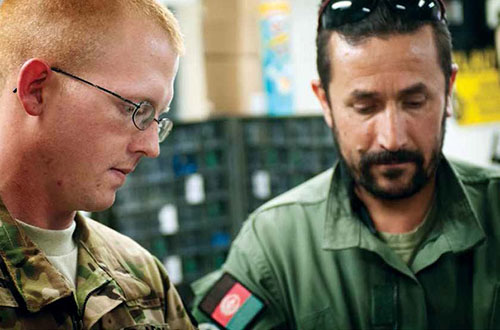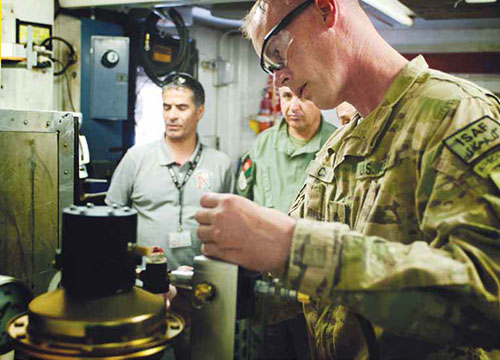
US-Afghan partnership leads to aircraft maintenance improvements


Your average story about a U.S.-Afghan partnership involves a foot patrol with the infantry through some dangerous territory. Because of the terrain in eastern Afghanistan, helicopters are critical for troop and supply transportation. When Americans head home, we’ll take our air support with us, leaving Afghan forces to continue the aerial mission themselves.
This partnership isn’t about guts-and-glory battles with the Taliban, but about battles that won’t take place once the United States is gone unless the country’s helicopter maintenance programs progress to self-sufficiency.

The 82nd Combat Aviation Brigade hasn’t had much opportunity to partner with Afghan forces. U.S. Army Lt. Col. Darryl Gerow, 122nd Aviation Support Battalion (ASB) commander, a former special operations pilot and 160th SOAR company commander, sought colleagues working with federal police forces who frequently use helicopters to see what he could do to improve Afghan aviation assets.
“They have helicopters that need to be fixed, and we have helicopters that need to be fixed, so we thought ‘let’s put a program together, see if they’re receptive to it, and make something more enduring,’” said Gerow, a native of Middletown, N.Y.

They partnered with the Afghan Special Missions Wing (SMW), formerly known as the Air Interdiction Unit, a special federal police unit operating under the Ministry of the Interior (MOI).
“This is day one of what we hope to be an enduring process, going forward and partnering with Afghan helicopter maintainers,” said Gerow.
According to a May 13, 2010, Air Force news article, the SMW is a U.S. Army-mentored counter-narcotics aviation unit stationed at Kabul International Airport, which provides support to a variety of ground units with its fleet of Mi-17 helicopters. The Afghan-only Mi-17 crews regularly conduct training and operational missions in support of the MOI, the Afghan National Police and other counter-narcotics forces around Afghanistan.
The U.S. Army’s 122nd ASB provides mechanic support to the 82nd CAB’s nearly 200 airframes, tearing apart and reassembling helicopters in record time to maintain a constant aviation presence over the Regional Command-East battlefield.
Afghan maintainers currently operate under an old Soviet maintenance model, which means “everyone does everything.” They lack the specialized shops Americans use — a system which allows each section to focus knowledge on a specific piece of the aircraft, coming together to accomplish the large project much faster.
“One of the things we show them is how we set up our shops, our maintenance, our avionics, and our production control to give them that exposure,” said Gerow. “The other thing it gets them is exposure to just tools, processes, how we work, and how they might be able to adapt that to their own aircraft.”
Americans and Afghans swarm a U.S.-built CH-47 Chinook. The aircraft is different from the Russian-made Mi-17 the Afghans operate, but they catch on quickly.
“We showed them the engine, then we went for a break, and when we came back they were already on the other one, and they were doing a pretty good job,” said U.S. Army Spc. Israel Vela of Houston. “Basically, we just supervised them from that point on. They catch on quick. They kept on saying it was too easy. They could probably fix anything.”
“Even though they’re different aircraft, sheet metal is sheet metal, avionics are avionics, hydraulics are hydraulics,” said Gerow. “So they might be different airframes, but what makes a helicopter fly is all the same.”

The hope is Afghan maintainers can take back some of the safety measures they learn on the aircraft and apply it to their own equipment.
“We came here to learn new techniques,” said Afghan Lt. Col. Abdulsatar Noori, the SMW maintenance unit commander, via a translator. “We haven’t seen anything like this before, so we’re trying to learn a new way of doing things.”
In the hydraulics shop, Noori learns to make a hydraulic line, then test it under 3,000 pounds of pressure to check his work. As U.S. Army Sgt. Joseph Carr, of Pensacola, Fla., shows the senior commander the process, the group looks impressed. They talk excitedly between one another, pointing first at the testing bench, then the hydraulic line in Carr’s hand. The impression is they may have just solved a problem in their own shop.
“What we learn here, absolutely, we can use these things,” said Noori. “This is what we hope to use in the future. We can think, ‘OK, we’ve done this before’ when we take it over there. We learn new ways of doing things, and we can apply them because the basic techniques are similar.”
Beyond technical knowledge, both the Afghans and Americans enjoy working with and meeting each other. They were a bit weary of each other early in the morning, but by lunch time, troops from both countries are working side by side.
“It was fun teaching and I like to learn,” said Vela. “It’s a two-way street. These guys have 20 or 30 years of experience. It’s actually a little intimidating. I’m only two years in the making. They learn, I learn, they teach, I’ll teach, and everyone benefits.”
For the 122nd’s Afghan partners, the opportunity is a point of pride to show off their knowledge and learn to apply their skills in new ways.
“If I work here for one more day, I don’t need any more help; I can install an remove an engine on a Chinook aircraft easily,” said Afghan Sgt. Said Igball, an SMW mechanic. “Next time I want to work on removing and installing rotor blades, work on transmissions, and go deeper and learn more about this aircraft. It is all so interesting.”
The hope is to continue the program, establishing a training schedule and milestones, then pass it off to the 101st CAB when the 82nd leaves in about three months.
“My goal is to get the ball rolling on an initial partnership program, and turn the blueprint over to the 101st when they hit the ground,” said Gerow. “Right from day one, they’ll have nine months to make a more enduring program, process, educational tools, and partnership effort.”
